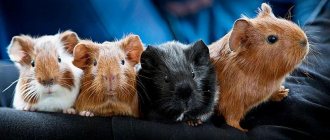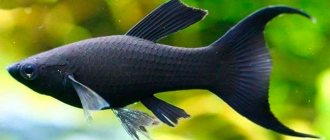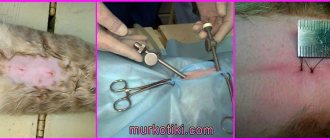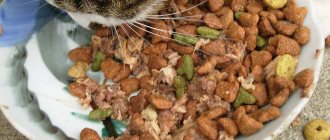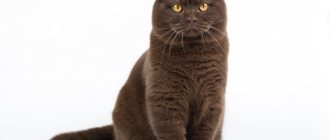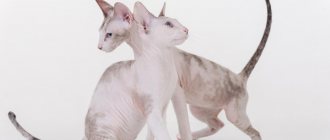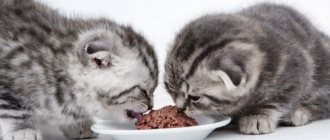Mating Scottish cats and, in particular, breeding Scottish Fold cats requires special attention. If the animals were bred incorrectly, then the offspring may have defects or health problems may arise in the adult.
Scottish cats are famous for their beautiful body, pretty look, soft fur and friendly disposition. Raising such cats at home always brings a lot of positive emotions to both adults and children.
When to castrate a Scottish Fold cat
Pregnancy is one of the special periods in the life of cats, which begins from the day of immediate mating and ends with childbirth.
It is considered normal if prenatal contractions occur between 63 and 66 days from the start of the fetal birth. Kittens born before day 58 usually do not survive.
If the cat has not given birth after 68 days, the owner should immediately call a veterinarian.
It is not difficult to recognize pregnancy; there is slight weakness in the morning and a decrease in the activity of the animal, in some cases there is nausea and vomiting.
This state lasts 10 days while the body adapts to other living conditions.
After 21 days, secondary signs of expecting offspring appear - the papillae swell and the taste changes.
Food must be saturated with vitamins, minerals and other beneficial substances, following the doctor’s recommendations.
Change of habits
Change of mood on the face
It also happens that a good mood changes dramatically and your beloved pussy becomes disobedient and even aggressive. If such circumstances arise, there is no need to touch her, and if she needs communication again, she will come up on her own.
You should not show the desire to feel your stomach with your hands; inept actions can cause harm and even provoke a miscarriage.
If you are not sure that the cat is healthy, you can contact a veterinary clinic to schedule an ultrasound examination. Starting from day 20, the kitten’s heartbeat can be felt in the womb. An examination by a specialist will only give the owner a good mood that the animal is not sick and therefore does not need therapy.
Morning vomiting at 3 or 4 weeks of pregnancy is caused by stretching of the uterine muscles and hormonal imbalances in the body. All these negative consequences disappear after a few days and the owner should not be particularly wary.
We'll be giving birth soon
If the pregnancy is successful, then in the period from 4 to 5 weeks from conception the embryos will grow significantly, and at week 6 the belly will grow even more, all the free space of the uterus will be filled. It is not surprising that it is at this time that the cat is looking for a secluded place for future children.
During pregnancy, the use of drugs containing chemicals should be completely avoided, but if problems arise, a visit to a specialist is necessary.
In the last week of gestation, the mammary glands swell, and the cat becomes inactive and looks thoughtful.
As a rule, at 7 weeks the kittens begin to move, this can be felt by a light touch of the hand or visually.
When the belly becomes large, it is difficult for the animal to clean itself up after visiting the toilet, so it is important for the owner to wipe around the anus with a piece of sterile bandage or gauze to prevent the penetration of germs
Another interesting fact: it is noted that at 3 or 6 weeks of pregnancy, some cats may go into heat, which, as it turns out, is due to insufficient progesterone production.
And if a cat is nearby at this time, then another fertilization may occur during repeated mating.
General recommendations
Mood swings are not the fault of the cat, but the fault of hormones
During this important period of life, the cat becomes interested in its changeable mood, attitude towards its favorite food, some of them like to rest more, and there are kitties that frolic.
In any case, the owner needs to be attentive and sensitive towards his pet. Affection, understanding and love will only give the cat confidence that everything will be fine.
And when kittens are born, the joy will be several times greater. After all, this is a miracle - small cat children, helpless, cute and, of course, beautiful.
Very often, a furry friend is created without the goal of breeding it. Having reached puberty, cats begin to mark their territory, and to avoid this, they are castrated. The question arises at what age can one be castrated? This should not be delayed.
It is optimal to castrate a Scottish cat at 7-9 months. If the operation is not performed in time, the mature kitten will experience discomfort from the inability to satisfy its natural desires.
No special care is required for your pet after surgery. However, care must be taken to ensure that the cat does not lick the wounds and thereby tear the stitches; this can harm the pet’s health.
What to feed fold-eared cats.
Fold-eared pets are not picky about food. You can feed them both natural food and special food for cats. In the process of feeding, you should take into account the tendency of this species to obesity and not exceed the required amount of food corresponding to the age and weight of the pet.
Feeding kittens
Kittens need to be fed more often than adult cats because they need more protein and nutrients during growth and development.
The number of feedings should be 4-5 times a day. At one month of age, kittens can be given boiled chicken meat, eggs and fermented milk products (cottage cheese, kefir, milk).
In addition to natural products, you can also use special commercially produced food for kittens. For example, Royal Canin or Whiskas.
Starting from the second month, kittens can be switched to food for adult cats. Kittens should not be fed cold or hot food, as this can cause various diseases.
Food for adult Scottish Fold cats
Adult cats can be fed dry commercial food in the mid-price category. The most useful and balanced in composition are the following foods:
- Purina;
- Almo Nature;
- Royal Canin;
- Brit Care;
- Hill's;
In addition to the required amount of proteins, fats and carbohydrates, they also contain vitamins and minerals that cats need for full growth and development.
If the owner has enough free time, it is recommended to prepare food for the pet from natural products. Among the foods that adult cats can consume without harm are the following:
- Meat: boiled chicken, beef, liver;
- Cereals: boiled rice, buckwheat, pearl barley;
- Dairy products: cottage cheese, kefir;
- Raw eggs (no more than 1 time per week);
- Vegetables: carrots, cucumbers, celery, bell peppers, cabbage.
It is recommended to combine meat ingredients with cereals and vegetables, while adding a little vegetable oil to the finished dish.
The amount of protein in cooked food should be at least 60%. It is enough to feed adult cats 2-3 times a day, while the weight of the daily food intake should be no more than 5% of the cat’s weight (for dry food - no more than 2.5%).
At what age should you start mating?
A cat's puberty begins at 8 months of age, which is when the animal begins its first heat. Nevertheless, the most acceptable age for mating is considered to be 1.5 years; it is at this age that you can breed a Scottish cat for the first time without compromising its health.
Veterinarians do not recommend mating animals if the cats are in heat for the first time. All continuing signs of estrus are extremely unpleasant for the animal; the cat may develop a nervous breakdown and depression. A female can be paired with a male during her third or fourth heat.
If Scottish Fold cats are mated before one and a half years of age, this can cause difficult births, pathologies in the kitten, and even the death of the cub. For males who are not ready for fertilization, early mating threatens the development of infertility, so it is better to wait until the pet is physically mature.
Estrus in cats lasts several days. How many days a Scottish cat walks depends on its individual characteristics. But in any case, 2-3 days of estrus are considered optimal for conception.
Cats go for walks 2 times a year. Usually the mating season occurs in early spring, but a cat can go on a spree in winter. Also, estrus occurs in late summer and early autumn.
How long do pregnant Scottish women walk?
It is very important to know how long pregnancy lasts in Scottish cats. After all, complications may arise, and you need to be on guard
On average, this period lasts 63-67 days or 9-10 weeks.
In the first 2-3 weeks of pregnancy, the fetus is just beginning to form. Paws appear and internal organs form. It is not yet possible to determine if a cat is pregnant by its appearance.
3-5 weeks - the expectant mother's hormonal levels change, so she may become overly affectionate or aggressive. The belly begins to grow. The cat eats more and tries to find a secluded place. Fetuses develop a brain, skeleton, endocrine system and muscles.
5-7 weeks - the cat becomes inactive and prefers to lie down. The fruits begin to grow hair. They already look like kittens, have all the organs, but are still light in weight.
7-10 weeks - the belly has grown even more. The fruits gain mass during this period. The cat becomes restless, increasingly looking for a secluded place. Sometimes it is near the owner, caressing, following him.
It’s easy to calculate pregnancy by week, the main thing is to know the mating date.
Complications may occur during pregnancy
You should pay attention and contact your veterinarian if:
- the period has exceeded 68 days;
- labor began before the 63rd day;
- the cat is lethargic and has a high fever;
- the animal does not eat for several days in a row;
- any discharge began before the due date.
The cat needs to be fed well, monitor its condition, not allow it to jump from heights, and handle it carefully.
Recommended Products
The diet largely depends on age and personal eating preferences. But regardless of this, a Scottish woman should consume the following types of foods.
Squirrels. They should be an essential component of nutrition, as they ensure the development of all types of tissues and muscles. Proteins of plant and animal origin must be present in the diet. It is necessary to give your favorite lop dog lean turkey, beef or chicken every day.
Fermented milk products such as kefir, cottage cheese, fermented baked milk and yogurt improve digestion and provide the body with calcium. It is an important component in the formation and strengthening of the skeletal system, teeth and claws.
Such products can be given in small quantities, and preferably low-fat or with a small percentage of fat.
Vegetables. Almost all types of vegetables will be well digested and absorbed in the pet’s body. The exception is white cabbage, which causes fermentation and stagnation in the stomach.
Vegetables should only be served boiled. They can also be grated and added to meat.
READ Protecting the species diversity of the planet, the rarest animals of the Red Book
Cereals. Oatmeal is best. It improves digestion and stimulates intestinal function. Rice can cause constipation. Therefore, it is better to focus on the preferences of the cat itself.
Fish. During pregnancy, it is better to exclude it from the diet. But you can give small amounts of salmon, trout, mackerel or sardine meat, which contains fat-soluble vitamins.
If a Scottish woman prefers to eat ready-made food, then the best of them will be premium or super-premium class, created specifically for pregnant women.
Cheap food will not do any good. Due to the insufficient content of vitamins and minerals in it, her health may deteriorate.
Postpartum rehabilitation
Let us dwell in more detail on the moment when the cat has already given birth, but for some reason cannot take care of the kittens, the owner must do the following:
- clean the kitten from postpartum film;
- place the kitten next to the mother;
- if necessary, carefully trim the umbilical cord at a distance of 4-5 centimeters from the navel;
- If necessary, wipe the kitten with a dry towel.
If the kitten does not move, you should carefully take it into your palm and shake it several times. Perhaps the mouth and lungs are filled with birth fluid. If this is the first kitten, you can put it aside on a dry diaper to protect it from the contractions of the British cat. The interval between the birth of kittens ranges from 10 minutes to an hour.
When the birth is completed, the family should be placed in a specially prepared place or left in a box. Provide food and water to help the cat recover after giving birth. A British cat may have discharge for several days. As a rule, this is a phenomenon of one or two days. If the process is delayed, you should consult a doctor.
For diarrhea, you should feed with rice water and boiled water.
Oatmeal and warm milk will help with constipation. Close attention, affection and understanding will help significantly ease the birth of a British cat and avoid any negative consequences. For example, a miscarriage, which can lead not only to the loss of offspring, but also to surgical intervention
How long do British pregnant cats walk: timing, stages and features by week
Let's pay attention to a brief description of the animal's condition at different weeks of pregnancy:
1 Week. The pregnancy of a Scottish Fold cat is almost impossible to notice. The nipples swell slightly and their color changes, but even experienced breeders find this difficult to notice. In the womb of the expectant mother, fetuses are already being formed, their number and the sex of the babies have been determined. Cell division after fertilization occurs after 60 hours. Division continues every 12-14 hours. Around day 4, small clusters of cells form, from which the future baby will form. Week 2. Using an ultrasound machine, the doctor can already determine whether the cat is pregnant or not.
Experienced breeders can feel the fruits with their fingers, but this should be done extremely carefully so as not to harm future kittens. Palpation is strictly not recommended for novice owners! The fetuses in the womb are still small, but are actively developing. Week 3. It is during the third week that cats begin to experience morning vomiting.
It usually lasts no more than a week. This stage of pregnancy is interesting because the Scottish cat exhibits an interesting feature - superfetation. This is the repeated mating of a cat with a cat, perhaps not even the father of the future kittens. Superfetation is extremely rare in humans, but it is quite possible in every tenth cat. But in order to mate again, you need to be in heat, the inquisitive reader will tell you. Right! But it can be triggered by many factors. 4 and 5 weeks. At this stage of pregnancy, the cat’s behavior changes dramatically. In addition, at 4-5 weeks there is a high chance of miscarriage, so it is extremely important that the Scottish Fold cat approaches pregnancy absolutely healthy. Babies develop bones, although they are still made of cartilage. Muscles, teeth and genitals develop. Babies can hear their heartbeat. By the end of the 5th week, the fetuses completely occupy the uterus. The skeleton is strengthened, most of the internal organs are formed. 6 and 7 weeks. By this time, the cat becomes noticeably fatter and activity subsides. But a pet can fall from a height and damage its offspring. The pregnant mother should be especially closely monitored. It is difficult for a cat to take care of personal hygiene; its stomach prevents it from licking its fur and organs. After visiting the toilet, the owner should take a cotton pad and wipe the pet. The cat begins to eat less, preparing itself for childbirth. Kittens develop fur in the womb, they have grown significantly and are actively moving in the stomach. Weeks 8 and 9. The cat is actively preparing for childbirth. He sleeps a lot and is not active, sometimes trying to find a secluded place to give birth. It is not difficult to prepare a “maternity ward” in an apartment in advance, but this should be taken care of in the first weeks of pregnancy.
If this happens, there are several possible scenarios:
- the offspring will die completely;
- babies born after the second conception will not survive;
- the cat will give birth to both litters, but they will be weak and will require additional strength to deliver them. A cat cannot do this alone. The embryos develop a body, head and internal organs. You can even see a small tail!
Color-point kittens are monochromatic in the womb. The color depends on the temperature of the area of the body where the fur grows. Inside the cat's mother, the temperature is uniform, but after giving birth, the color of the kitten's fur changes. He independently regulates his body heat. If the gestation period has exceeded 70 days, the owner should contact a veterinarian.
Preparing the birth site
For the normal birth of kittens, a fold-eared cat, like any other, requires comfortable conditions. The birthing box should be prepared in advance so that the pet has time to get used to it
It is very important that the environment in which the cat will give birth is homely and familiar to her. The birth box needs at least the following dimensions:
- length – 60 cm;
- width – 50 cm;
- height – 50 cm.
If the cat is very large, a larger box may be required. It is best to make one of its walls removable. This will allow, after the kittens are born, to carry out all the necessary actions to keep the bedding clean with the least amount of worry, and will also prevent the cat from jumping into the box from above, during which she could accidentally injure, or even kill, the kitten. The ideal bedding would be a thick layer of newspaper.
The kitten birth box should be placed in a warm, dry room in a dark place. The birth should take place without people or animals being strangers to the cat, which can become an additional source of stress for the Scottish cat, which will make the birth process more difficult.
What is suitable as food?
If you feed your cat natural foods, you need to make sure that it is a diet rich in protein, calcium and taurine. These substances are found in meat and dairy products, and the amino acid taurine, which is so beneficial for the heart, is found in beef heart. If the cat is fed commercial food, it should be pregnancy food, rich in calcium, protein and taurine.
During pregnancy, a Scottish cat needs a complete protein diet. An excellent product is chicken gizzards that have not been peeled, because... it normalizes the intestinal microflora and improves its natural cleansing. The stomachs also contain folic acid, necessary in early pregnancy, and a complex of vitamins and microelements. The foods of choice during pregnancy are also chicken hearts and pork heart, which are also rich in vitamins and microelements.
Note from the MURKOTIKI website. If you include any chicken products in your cat's diet, you must buy them from a trusted manufacturer: not from a poultry farm that uses hormones and harmful additives. If it is not possible to buy chicken from a good producer, the product will have to be excluded from the diet.

